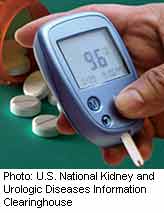- Skip Storing This Everyday Product in the Fridge Door
- Green Tea + B3 Pairing May Boost Brain Health
- Navigating Your Midlife Crisis: Embracing New Possibilities
- City Raccoons Showing Signs of Domestication
- Mapping the Exposome: Science Broadens Focus to Environmental Disease Triggers
- One Week Less on Social Media Linked to Better Mental Health
- Your Brain Changes in Stages as You Age, Study Finds
- Some Suicide Victims Show No Typical Warning Signs, Study Finds
- ByHeart Formula Faces Lawsuits After Babies Sickened With Botulism
- Switch to Vegan Diet Could Cut Your Greenhouse Gas Emissions in Half
Some Helpful Hints When Monitoring Blood Sugar


Anyone who needs to monitor their blood sugar can take some simple steps to improve their test results. These include:
Wash your hands before you test. It sounds simple enough, but it’s a step many people skip or skimp on.
“Tests strips are essentially little labs on a piece of plastic,” explained Dr. David Simmons, chief medical officer at Bayer HealthCare’s Diabetes Care in Tarrytown, N.Y. “If you have sugar on your hands, it will get into the blood sample. This is one of the predominant causes of a high blood sugar. So, wash your hands with soapy water, rinse well and dry thoroughly. If there’s extra fluid on your finger, it will dilute the sample and give you a lower reading.”
Skip the alcohol swab or hand-sanitizing gel. Like having extra sugar on your hand, alcohol can affect your blood sugar reading, too. “If you use alcohol swabs, it’s only OK if you guarantee you don’t have residual alcohol, so make sure you dry it well and then wipe it with a clean cloth,” Simmons said. “But, it’s best not to use alcohol.”
Don’t forget quality control. Do you check a test strip from each new batch with control solution to ensure that the results are in range? If not, you might not be getting accurate readings.
Be sure to use the right control solution for your test strips and run a check every time you open a new container of strips, each time you get an unusual result, and any time you’ve dropped your meter, according to the U.S. Food and Drug Administration. To run the test, insert a test strip into your meter and then put a drop or two of control solution on the strip, like you would if you were doing a test with your blood. The results should be within the range listed on the test strip bottle. If they’re not, call the manufacturer to report the problem.
Storage is important. Again, because test strips are essentially tiny labs, it’s important to keep them in the right conditions.
Don’t store test strips in your car or anywhere else that gets very hot. Ditto for anywhere that gets excessively humid, which definitely makes the bathroom not a good storage area. Extreme cold can be an issue for tests strips, too, according to Simmons.
Heed the expiration date. Test strips degrade over time so it’s important not to rely on a test strip that is past its expiration date.
“Manufacturers work very hard to try to incorporate safeguards into meters and test strips,” said Courtney Lias, director of the division of chemistry and toxicology devices for the FDA. “For example, they try to make sure that no result is given if a test strip is under-filled.”
But, as with any lab test, errors can sometimes occur. She said that if you get a test result that doesn’t seem to match the way you feel, such as an abnormally high number when you have no symptoms of high blood sugar, be sure to check again before making any treatment decisions.
More information
Just how accurate are home-based blood sugar tests? Read this HealthDay story to find out.
Source: HealthDay
Copyright © 2025 HealthDay. All rights reserved.










